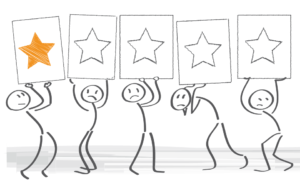Few years ago, I needed to enroll my child in a primary school and was checking some schools. I got to one particular school, after talking with their representative and she showed me around the school, everything seemed fine. I decided to enroll my child in the school.
-
Nipping customers’ journey to disloyalty in the bud
No organization wants to lose customers. Hence organizations always strive to prevent customer disloyalty. However, to succeed in doing so, it’s essential to first understand how customers become disloyal.
-
The Importance of Service Processes
Early this year, I ordered an item from an online shop with a promise of next-day delivery. The following day, I got the item. Impressed by their service, I ordered another item in February, but it came after 4 days, with profound apologies. Last month, with reluctance, I ordered another item from the same shop. After 3 days, I was told the item was out of stock. Disappointed, but at least I got my money back. However, I’ll not buy […]
-
Understanding value from the customer’s perspective
No matter what product or service you provide, it is the customer who defines value. Hence, to succeed, it’s essential to see value from the customer’s perspective. If not, you will not understand the actual needs of the customer.
-
The Cost of Poor Service
Poor customer service creates a leak in your organization, causing potentially loyal customers to slip away. In other words, poor service will cost your organization money. Lots of money. You incur this cost in two ways . . . Your customers won’t come back Your customers won’t recommend you to anyone So where is all the lost money going? 1. Direct loss of sales Have you ever tried to buy something from an organization, and their service became so poor […]
-
Making Customers Satisfied is Out of Date
When you provide the right service at the right price, at the right time, and to the agreed-upon specifications, the customer is satisfied. This is the mission of most organizations because they assume that it is sufficient to satisfy customers. But studies conducted on the relationship between customer satisfaction and customer loyalty show that this assumption is deeply flawed. Xerox, for several years in the past, polled 480,000 customers per year regarding product and service satisfaction using a five-point scale […]
-
The 2 Things Customers Really Want
First is to be treated well. Second is to get the expected result. To help explain these two things, the following scenario will help: Yetunde wants to withdraw money over the counter from her bank account. We might consider the service to have the following stages, in order: Arrival at the bank Reception at the revolving security door Waiting to withdraw Interaction with the cashier while withdrawing Cash collected Departure She had gone to the bank and withdrawn money. Here […]
-
Using Service to Create a Competitive Edge
Many organizations think that the only way to grow their business is to find new customers. But often, the best source for growth is sitting right in front of you: existing customers. Finding new customers aids business growth but here’s an important fact: Studies show that the probability of selling to an existing happy customer is up to 14x higher than the probability of selling to a new customer. See Figure 1. Figure 1 Hence it makes perfect sense to take […]
-
The service quality factors for competitive advantage
The service quality factors are those attributes of service about which customers may have expectations and which need to be delivered at some specified level. They vary from organization to organization and also from customer to customer, so it is difficult to capture every aspect of service quality for every organization. However, the following is a good attempt that can help organizations start to define, deliver and measure service quality: access, aesthetics, attentiveness/helpfulness, availability, care, cleanliness, comfort, commitment, communication, competence, […]
-
2 Gaps that Dissatisfy Customers
Satisfaction is the result of customers’ assessment of a service based on a comparison of their perception of service delivery with their prior expectations. (see Figure 1 below). Figure 1 If the customers’ perception of the service matches their expectations then they should be satisfied. If their perception of the service exceeds their expectations then they will be more than satisfied, even delighted. If their perception of the service does not meet their expectations then they may […]











